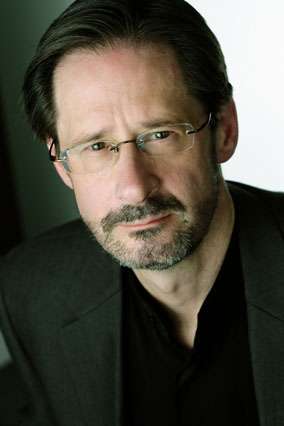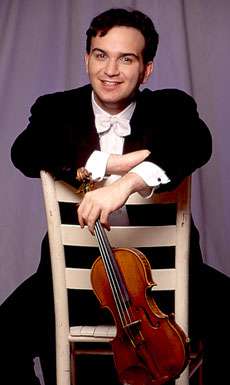|
Back
The Sparkling American Showcase New York
Avery Fisher Hall, Lincoln Center
11/29/2012 - & November 30, December 1, 2012
Steven Stucky: Symphony (New York Premiere)
Samuel Barber: Concerto for Violin and Orchestra, Opus 14
Sergei Rachmaninov: Symphonic Dances, Opus 45
Gil Shaham (Violin)
New York Philharmonic Orchestra, Alan Gilbert (Conductor)

S. Stucky (© Hoebermann Studio)
Nobody questions Steven Stucky as one of America’s composing stars of the moment. Not quite an icon, he has become established for his brilliant orchestral scores, illuminating, glowing glowing, that show the splendid craftsman–and frequently the inspired artist–at work. And while the New York premiere last night was allegedly his first Symphony (New York Philharmonic Co-Commission with Los Angeles Philharmonic), Mr. Stucky confessed in a pre-concert interview with Alan Gilbert, that he had written four symphonies in his youth, all of them discarded.
The work he wrote this year will obviously not fall not fall into that class. In fact, this was one of those very rare premieres where one wanted a second hearing, not to get to the “deeper meaning” or attempt to gauge a complicated structure. One wanted a repeat because it was so accessible, so very very stimulating on a first hearing.
Messrs Gilbert and Stucky, in their talk, had agreed that writing symphonies was not the most fashionable form this century. But the composer went further. One of his goals was to “make the hair on the back of the neck stand up”, or to be a good emotional experience.
Other composers might not agree. But Mr. Stucky, in a brief 20 minutes, with four connected titled movements, filled that bill. Starting with some almost Oriental wind passages, he continued with other consorts of the orchestra, building to a tremendous climax in the first movement, “Introduction and Hymn”, following with a more relatively doleful “Outcry”, with a joyful scherzo, linking them together thematgically, a peaceful, meditative “Hymn and Reconciliation”.
There were parts of Symphony where it seemed a mere Late American Romantic work, something like Samuel Barber’s orchestral essays. But Mr. Stucky, while writing 70 years after Barber’s music, is never ever afraid for that emotional punch. He did not shy away from grand climaxes, massive crescendos, and a brass chorale which was one of the most lavishly beautiful things I’ve heard from any contemporary composer.
Mr. Stucky puts the orchestral forces to work (as he did in his fine Concerto For Orchestra), but never for the sake of mere virtuosity. I have a feeling that some erudite listeners last night might have felt cheated, wanted something more enigmatic, more abstract. But this is not Mr. Stuckly’s way. Like any composer, he does not write in order to please his audience, he composed this Symphony because it had to be composed. And for that reason, it is a reflection, perhaps, of Mr. Stucky’s own open, optimistic, and creative look at this world.
So yes, let us hear more of it. Perhaps, in fact, when Los Angeles Phil conductor Gustavo Dudamel (who premiered it there) comes to New York, we can hear a different interpretation. It could be equally satisfactory.

G. Shaham (© Boyd Hagen)
Not only was this program made from three American composers (Rachmaninov took his citizenship a few months before his death), but the last two pieces were written in the same year, 1940. And like Mr. Stucky, both Samuel Barber and Sergei Rachmaninov lay their hearts on their manuscripts. Both were unashamedly Romantic, and both produced works that are forever etched into the American soul.
While the Adagio is Barber’s “immortal” contribution, his Violin Concerto is deservedly popular, not only for its sheer melodic beauty but a climax which would tax the skills of any performer.
Its original dedicatee rejected that finale, saying it was “unplayable” But nothing is unplayable for Gil Shaham. His technique is flawless, his understanding is deep, and his physical movements–sometimes resembling a restaurant fiddler as he sashays from one side of the stage to the other–is endearing rather than off-putting.
I think the opening bars of the Concerto are as sheerly beautiful as anything written in America, so was a bit disconcerted to hear how casually Messrs Gilbert and Shaham played it. Obviously, they were waiting to build it up for the grand climax of the movement. The ironic thing was that Mr. Shaham took this work with such ease, such flexibility that the near-impossible ending became an inevitable, unsurprising bit of Shaham magic.
If I had my druthers for star composer, violinist or conductor last night, the accolade would go to Alan Gilbert and the Symphonic Dances. I had heard an evening of breezy Rachmaninov piano the previous night, but this was the composer at his most demonic. Mr. Gilbert seemed a man possessed, driving the New York Phil through their paces with whiplash intensity. If Mr. Stucky’s work was highly pleasing, if Mr. Shaham gave a delightful show, Mr. Gilbert gave us fireworks, excitement and a marvelous display for himself and his orchestra.
Harry Rolnick
|